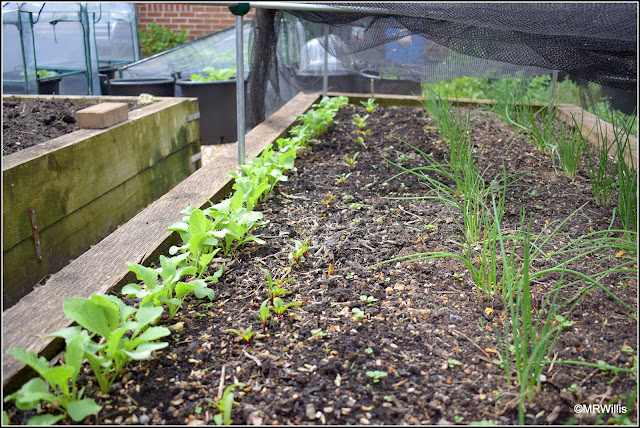There has been a huge surge in the popularity of home baking during the coronavirus lockdown. Shops everywhere have run out of flour! I have been talking about bread-making with several of my social media friends and some of them have asked me which recipe I use for making sourdough bread. The answer to this is "my own recipe, but adapted from one I learned on a course at
Bread Ahead a couple of years ago". I thought it might be nice to share this recipe with you, so here goes... (Sorry about the lack of photos covering the middle section, but I hadn't thought of writing this post at that point.)
[If you would like a copy of the recipe in Word format, without the photos, drop me a line at mwillis@ntlworld.com and I'll email it to you.]
White Sourdough
Bread Recipe
(Makes one loaf – nominally 600g)
Stage1 – make a Rye Starter (most people will
already have this or an equivalent)
Day 1. Put 50g Rye flour in a suitable lidded container, add
50g cold water, stir thoroughly, cover loosely (e.g. lid half open), set aside
at room temperature.
Day 2. Add another 50g Rye flour and another 50g water. Mix
and store as before.
Days 3, 4, 5, 6. Repeat procedure described above. By Day 6
the starter should be bubbly and should smell pleasantly beery. If so, it’s
ready to use. If not, repeat the procedure as required.
Stage 2 – make a Stiff Starter or a Poolish.
[A Poolish is basically a sloppy version of the Stiff Starter,
and uses a higher proportion of water.]
 |
| My Poolish is in the square plastic container in the foreground. |
Begin with a lively Rye Starter. If your starter is not
lively, refresh it at least 8 hours (or up to 24) in advance, by discarding
about a third of what you have and replacing it with new Rye flour and water in
equal proportions.
To make a Stiff Starter, in a suitable lidded container
thoroughly combine 90g Strong (or Extra Strong) White Bread Flour with 45g Rye
Starter and 45g cold water. It should produce a stiff paste.
To make a Poolish (I use this method), thoroughly
combine 60g Strong White Bread Flour, 60g Rye starter and 60g water. It should
produce a fairly loose paste. You can make it sloppier if you like, by adding
more water, but just remember to add less water when you come to make the
dough.
Set your Stiff Starter or Poolish aside for 12 – 24 hours,
until it becomes nice and bubbly. If it becomes TOO bubbly, you can slow it
down by putting it in the fridge for a few hours, until you are ready to use
it.
Stage 3 – Make your dough.
Put 490g Strong or Extra Strong White Bread Flour in a large
bowl.
Add 10g salt.
Add your Poolish or Stiff Starter. (Although you will have
started with 180g of ingredients, it is likely that despite your best efforts
you will leave some behind in its container, so let’s say you have 175g or
thereabouts!)
Add 320g cold water
Mix thoroughly, using your hands, until there is no dry
flour left in the bowl. Add more water in SMALL quantities as required, but
don’t use more than 350g in total or your dough will be too sloppy.
When the dough begins to come together, tip it out of the
bowl onto your worksurface. Most authorities say “a lightly-floured
worksurface”, but I knead my dough on the kitchen worktop without using flour
because the worktop seems to have very good non-stick properties!
Knead the dough vigorously for 10 minutes, using the
“stretch and tear” method it you can. This involves pushing the dough away from
you very firmly with the ball of your hand and then when it begins to tear,
bringing it back towards you in a sort of folding action. The result is to
stretch the glutens in the flour, giving the dough strength and structure.
After 10 minutes of this you will be tired but you should have a nice smooth,
elastic dough.
Form the dough into a rough ball and put it into a clean
bowl. Cover it tightly with a plastic showercap or similar. [Warning: if you
use a fabric cover, make sure it is wetted and remains moist. Otherwise your
dough may form a hard crust, which is undesirable at this stage.)
Place the bowl in the fridge for 12 – 24 hours. This will be
the “First Proving”.
Stage 4 – refresh and shape the dough.
Remove the dough from the fridge and leave it for half an
hour to warm up.
Tip / scrape the dough out onto your worksurface (see above
concerning flouring).
Flatten the dough roughly and then do a “Stretch and Fold”.
This means pulling the dough out from the centre and then folding it back in.
After each such action, turn the dough through 90 degrees and repeat (4 such
actions equate to one Stretch and Fold). This gives the dough extra strength –
it’s a bit like building up muscles through exercising!
Shape the dough into a rough ball and either return it to
the bowl and cover it as before, OR leave the dough on the worksurface but
cover it with the inverted bowl.
Leave it for half an hour and then do another Stretch and
Fold. Form it into a rough ball.
Cover the dough as before, and leave it for 10 – 15 minutes.
Generously dust your Banneton (or proving-basket) with
flour. I use a mixture of Extra Strong White Bread flour and Rice Flour. The
different (rather grainy) texture of the Rice Flour helps to prevent the dough
sticking to the Banneton.
Uncover the dough and shape it. A good technique here
involves using your hand with palms uppermost and sliding them almost
underneath the ball of dough, whilst constantly rotating the dough until you
are happy with the shape. The upper surface of the dough should be smooth and
any irregularities will have been pushed underneath.
Gently move your dough into the Banneton and cover as
before, preferably with a plastic shower-cap or equivalent.
Place the dough in the fridge for 8 – 12 hours. This is the
“Second Proving”.
Note, if the dough is not rising very much, it may be a good
idea to give it a few hours at room temperature. However, I recommend that it
should always spend its last 1 – 2 hours in the fridge, which will help it to
firm-up, which in turn will make it easier to tip out of the Banneton.
Stage 5 – Final shaping and baking.
Pre-heat the oven to 240C – which is about the maximum to
which a normal domestic fan-oven will go.
Some people would at this stage put in the oven a pizza-stone
or an upturned baking-tray. I use a purpose-made baking “cloche”, which is like
a pottery pizza-stone but with a domed cover. It keeps in the steam and helps
the dough to rise whilst assisting the formation of a nice crispy crust. The
same effect can be achieved by using a cast-iron Dutch Oven. If using any of these items, put them in the oven as soon as you switch it on.
Coat a baker’s Peel with about 20g coarse polenta. The
polenta acts like tiny marbles and will help the dough to slip off the peel at
the desired moment. If you don’t have a Peel, use an upturned flat baking-tray.
 |
| The Peel, coated with polenta |
Take your dough out of the fridge “at the last minute” so
that it is still as firm as possible.
Upturn the Banneton over the Peel and tap sharply. The dough
should drop out.
Using a VERY sharp knife or preferably a dedicated “Lame”
(basically an old-fashioned razor-blade fixed in a handle for safety), slash
the top of your dough at least once, very deeply. This will allow steam to
escape during baking, thus avoiding uneven and unsightly cracking of the crust.
If you want, you can spend some time making additional fancy slash-patterns,
but this is for purely aesthetic purposes!
 |
| Dough after tipping-out from the Banneton, showing long deep slash in the top surface |
Using the palms-uppermost technique described above, give
your dough a final shaping.
If you are not using a cloche, open the oven and give it a
few squirts of water from a spray bottle. This will create steam which will
help with the texture of the bread’s crust. If using a cloche or Dutch Oven,
omit this stage, just remove its lid.
As quickly as possible, slide the dough off the Peel onto the
base of your cloche, Dutch Oven, or pizza-stone, replace the cloche / Dutch Oven lid if relevant and close the oven door.
Bake at 240C for 35 minutes.
Remove the lid of the cloche / Dutch Oven and turn the oven
temperature down to 200C (180C fan).
Bake for a further 15 – 20 minutes. During this time the
crust will colour-up. If it is going too brown for your liking, turn the oven
temperature down a little or cover the loaf with a piece of foil.
Test to see if the loaf is fully baked by lifting it in an
oven-glove or tea-towel and tapping it sharply on the underside. If it is
cooked you will hear a hollow sound. If not, it will make a dull thud!
When fully baked, remove the loaf from the oven and allow it
to cool on a wire cooling-rack.
 |
| The finished loaf. Despite the deep slash, the crust of this one still cracked! |
In my opinion, the bread is best eaten when just ever so slightly
warm, served with lashings of salted butter!
 |
| This texture is ideal for me - lots of air-bubbles but not huge ones! |
This sort of bread keeps best if wrapped in a cloth or clean
tea-towel.


















































